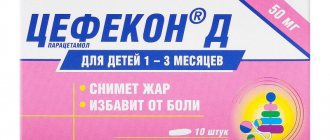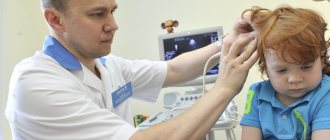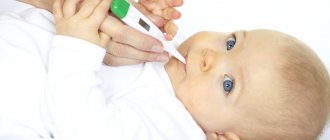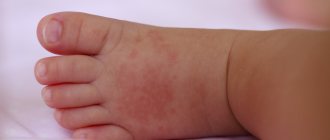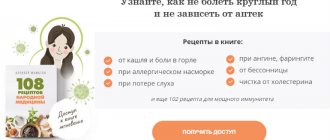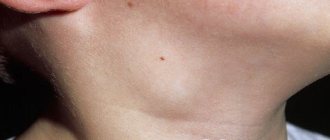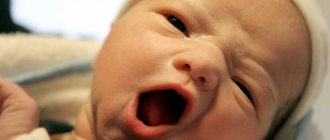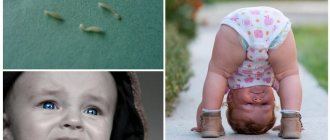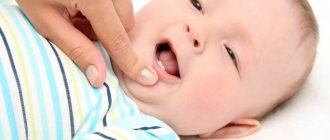Causes of illness
There are many prerequisites for illness, and only the attending physician can understand them. After all, the range of syndromes is quite wide - from muscle contractions when falling asleep and during sleep to epileptic seizures. Night cramps in children are not always classified as pathologies, because impulses to the nerve endings can arrive as a result of vivid sleep or uncomfortable posture.
Convulsions in children under one year of age are also explained by the rapid excitability of the central nervous system (CNS) due to its immaturity.
Such reactions in children are divided into epileptic and non-epileptic. Risk factors for the latter include:
- Hereditary disposition;
- Psycho-emotional disorders;
- CNS dysfunctions;
- Traumatic brain injuries;
- Metabolic disease;
- Heat;
- Reaction to vaccination;
- Intoxication of the body;
- Internal hemorrhages.
The cause of leg cramps in a child can be a deficiency of calcium, iron and magnesium. In a newborn, seizures can occur due to asphyxia, birth injuries, problems with the heart and blood vessels, and perinatal encephalopathy.
What are respiratory affective seizures? These are involuntary muscle contractions due to excess emotions. They usually appear in babies from six months to three years and are considered the most harmless.
Only a doctor can determine the cause of seizures. If they are accompanied by other painful symptoms and recur frequently, medical attention is necessary.
Results
Cramps in young children are quite common and look like involuntary muscle contractions in response to an external or internal stimulus. The condition can be caused by various diseases that can only be diagnosed by a doctor. But every parent should be able to provide emergency care for convulsive syndrome in children and notice the first symptoms of the disease. The attacks often go away as the child grows, but before the diagnosis is removed from the child, it is better to protect him from irritating external factors and strictly follow the recommendations of doctors.
Types of convulsive manifestations
Depending on how the attacks manifest themselves, they can be divided into several types:
Tonic
Character of muscle contraction: long-lasting. Because of this, the limbs seem to freeze in the process of flexion or extension. The baby's body is extended, and the head is thrown back or lowered onto the chest. Tonic convulsions last a long time. Their appearance indicates an overexcited state of brain structures. More often they occur in the extremities, for example, when a child has cramps in his legs. But they can also involve the stomach, neck, and face.
Clonic
Character of muscle contraction: fast. Periods of muscle contraction and relaxation in children occur dynamically and visually resemble twitching. They begin when a pathological discharge occurs in the brain centers or muscles. If their cause is not eliminated, the attacks become more frequent.
Tonic-clonic
Clonic-tonic attacks are characterized by alternating muscle contractions and increased tone. The final result may be loss of consciousness or even coma. This type of seizure often occurs due to epilepsy.
There are also myoclonic spasms. Their difference is that they pass completely without pain. Most often, myoclonic spasms occur during sleep. These include leg cramps at night, which wake the child up. But they can be caused by fear or overeating (for example, hiccups). In a newborn, myoclonic seizures are often associated with inherited ailments. Also, based on the coverage of skeletal muscles, doctors divide all seizures into two types: partial (local) and generalized (general).
The attacks are usually single. If repeated, we can talk about the occurrence of secondary myoclonus. The causes here may be various neurological diseases.
Types of seizures in infants
Neonatal cramps are muscle spasms that appear in a baby immediately after birth. Typically, such conditions indicate immaturity of the nervous system or the presence of a congenital disease. The symptom can be recognized by parents or during an examination by the attending physician, when mom and dad go to the pediatrician with complaints of constant crying. Based on clinical manifestations, several types of seizures in infants are distinguished. They can be limited or widespread and are classified according to symptoms.
Expert opinion!
Seizures in premature babies are common. Such babies are born weakened, all their organs lag behind in development. The main reason is the immaturity of the motor neurons of the cerebral cortex, when the connection between nerve cells and muscles is disrupted, spontaneous contraction occurs at the slightest fatigue. Sometimes the interaction in the hypothalamus becomes disconnected and spasms appear at fever, after vaccinations, poisoning and other conditions.
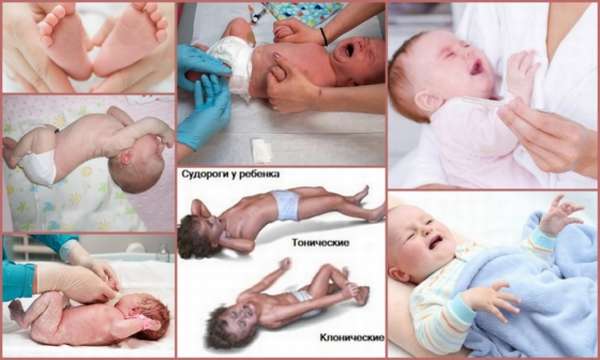
Minor seizures in a child
Such muscle contractions are common, but they may not be recognized immediately. They are not accompanied by pain and do not cause severe discomfort to the newborn - babies may not cry and play calmly.
Main features:
- Blue or pale skin - due to poor circulation,
- Twitching of the eyes or facial muscles,
- Trembling of the baby's arms and legs.
Minor convulsions are long-lasting and may last for several hours. Sometimes parents notice how the child’s head or limbs twitch in his sleep, and his hands and feet tremble.
Tonic
Tonic cramps look like prolonged spasms when a muscle contracts and does not relax. The leg or arm is tense, the child feels pain and a burning sensation - as the contraction grows, these symptoms intensify. They are observed at any age, affect one group of muscles, less often - they are widespread.
The latter condition is manifested by the following symptoms:
- The baby's whole body is tense,
- The head is thrown back
- Breathing may be impaired.
An attack of tonic convulsions requires immediate assistance, which is aimed at preventing complications during the attack.
Clonic
Such convulsions in infants are manifested by numerous muscle contractions - one muscle can contract 1-3 times in a second. Clonic spasms in newborns are divided into three categories:
- Focal - one muscle group contracts (lower leg, front thigh),
- Multifocal – several muscle groups are involved,
- Generalized - the most dangerous, characterized by the spread of spasms throughout the body.
These symptoms of seizures in infants are easily identified - the legs, arms and (or) head twitch strongly and rhythmically. Unlike minor spasms, attacks are accompanied by pain; due to contractions, the limbs begin to bend.
Myoclonic spasms
Myoclonic convulsions are a mixed variant of pathology in newborns, which is accompanied by strong and sudden contractions. Against the background of normal health, a sudden withdrawal of an arm or leg or throwing the head back may occur. Unlike previous variants, which affect the limbs segmentally, there is no symmetry here - the right arm and left leg can spasm at the same time, the head and foot can twitch.
Important!
Myoclonic seizures do not affect newborn babies, but can occur in older children. Their presence indicates congenital dysfunctions of the nervous system.
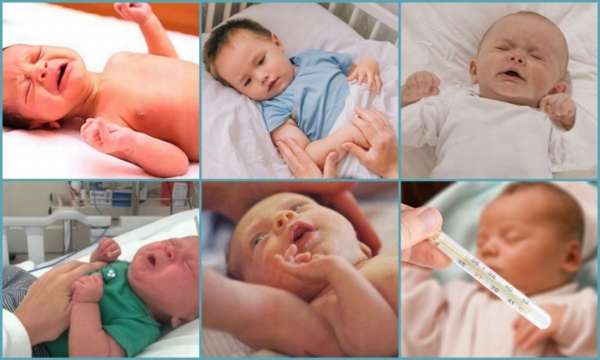
Febrile seizures in a baby
Febrile convulsions are a special type of spasms that occur against the background of an increase in temperature. Typical for newborns and infants, peak appearance is up to 3 years. They usually go away on their own by the age of 5.5-6 years and are not considered pathological. They are accompanied by generalized contractions and can affect the arms, legs and the whole body.
Respiratory-affective spasms
They manifest themselves against the background of emotional instability and are accompanied by breathing problems in the infant. Usually observed in the first 3 years of life, these are characteristic convulsions in an infant that appear during sleep. According to the observations of experienced doctors, the trigger for the development of symptoms is a change in the position of the body in space during night rest - when the newborn turns over on his tummy. This syndrome is accompanied by hysteria, severe crying and breathing problems.
Epileptic
One of the most dangerous manifestations of convulsive seizures is epilepsy, which indicates incurable damage to the nervous system of the newborn. In infants, such spasms are difficult to distinguish from febrile, clonic or mixed - the key point is age and diagnostic data. The attack is accompanied by:
- Contraction of muscles throughout the body
- Twitching of arms and legs,
- Throwing back the head
- Breathing disorders
- Defecation and urination,
- The appearance of foam at the mouth.
Loss of consciousness, memory and behavior disorders are often observed. Such convulsions begin to bother newborns and do not go away by 6 years.
Salaam's convulsions
Salaam convulsions are a type of epileptic spasms in infants. They are accompanied by movements of the head “back and forth” and swaying of the torso, arms and legs in the opposite direction. Such contractions resemble bows (hence the name “Salam”) and indicate a congenital lesion of the motor zone of the cerebral cortex.
Important!
Self-diagnosis of seizures is not allowed! If you suspect your baby has an illness, immediately visit your local pediatrician. The suspected disease requires laboratory and instrumental confirmation.
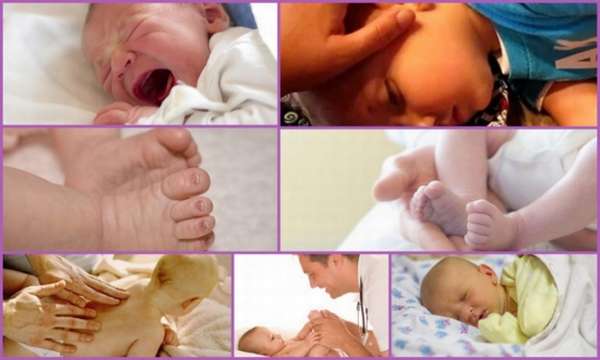
Febrile seizures in children
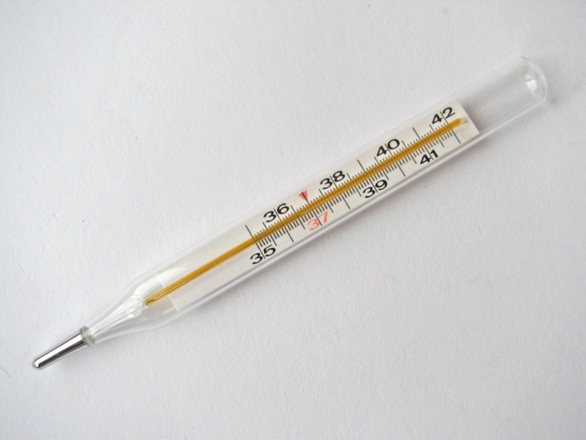
This is what they call seizures when a child has a fever. Preschool children are prone to such manifestations. Febrile convulsions in children with fever develop due to the fact that the baby’s brain is not sufficiently formed and is sensitive to various irritants. They are observed in a child at a high temperature: 38-39 degrees and above. Moreover, attacks are possible, even if they have not manifested themselves before.
What do cramps look like with fever? This variety manifests itself as follows:
- Detachment to the point of loss of orientation;
- Turning pale and holding your breath;
- Muscle twitching and freezing.
Convulsions in a child with fever are not considered normal, but in isolated cases they are not dangerous. The causes of febrile seizures are various infections of a bacterial and viral nature. Children may be genetically predisposed to such a reaction.
It is important to note: the faster hyperthermia develops, the higher the likelihood of convulsive conditions. However, there are also low-grade seizures. Such convulsions occur after a child has a high temperature, when the thermometer drops to 37 degrees. Usually they are repeated, with complications of the disease. However, such convulsions may occur during vaccination.
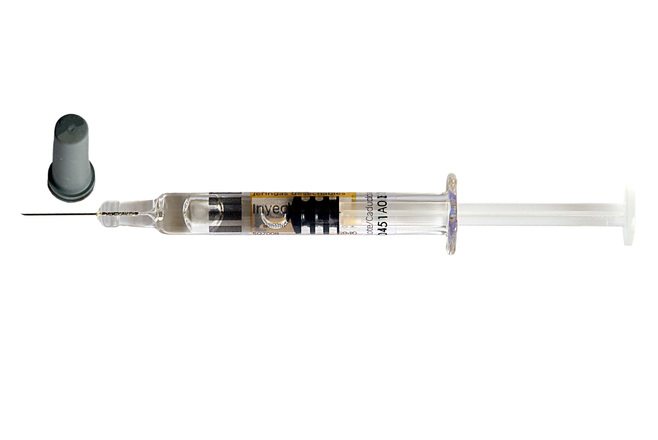
Temperature seizures often occur in a child with a disease caused by the Epstein-Barr virus. This disease is called infectious mononucleosis. It is often confused with a sore throat, but the Epstein-Barr virus is a herpetic virus. The majority of the world's population is carriers of Epstein-Barr infectious agents. But in preschool children, due to an underdeveloped defense system, the Epstein-Barr virus becomes more active and provokes a full-blown disease. Fortunately, after illness, immunity is developed. Even those who suffered from mild illness are no longer afraid of the Epstein-Barr virus. And the painful condition that is provoked by the Epstein-Barr virus can be easily relieved with modern medications.
Causes of seizures in a child
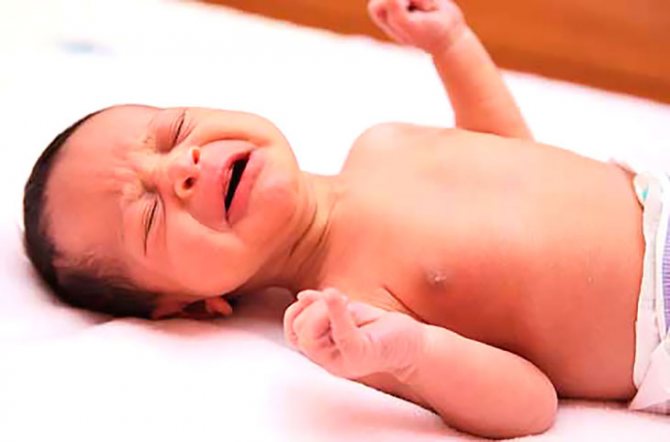
Parents should help doctors. It is important to carefully remember all the features of the child’s behavior, his sleep and eating patterns, the likelihood of possible injuries and, in general, any facts that were noticed before the development of the attack. Indeed, in most cases it is impossible to determine the cause of childhood seizures only by clinical manifestations, especially if they appeared for the first time and did not last long.
However, there are main reasons that most often lead to the development of convulsive syndrome in a child:
- Various diseases of the central nervous system (meningitis, increased intracranial pressure, tumors, hemorrhages and injuries);
- Hereditary and congenital diseases, with various metabolic disorders;
- Chronic intoxication of the central nervous system, both during pregnancy and after it (for example, overdose of drugs with side effects);
- Endocrinopathies and ion imbalance (a sharp drop in blood sugar levels - hypoglycemia, a decrease in the level of calcium and magnesium in the blood plasma, a drop in potassium levels with an overdose of “crude” diuretics;
- The vast majority of all seizures occur in young children due to fever and fever. They are called febrile (hyperpyretic). Their proportion varies in different age groups from 25 to 85%, and febrile convulsions in children with fever are most common;
- Actually, epilepsy.
Epileptic convulsions and epistatus are diagnosed when all possible causes have been excluded, and it is simply impossible to explain the occurrence of an attack, especially if the parents (or one of them) have epilepsy or have experienced convulsive seizures during their life. The incidence of epilepsy in children is much less than the number of febrile seizures. The frequency ranges from 0.5 to 1% of all cases of the disease.
In addition, the cause of seizures in a child can be so-called respiratory-affective conditions, in which the baby sharply expresses displeasure and a negative state. They are preceded by loud crying and screaming, with transient cessation of breathing and the development of cyanosis.
If the child is left to his own devices, the source of convulsions, especially in the summer and in nature, can be various poisonings with unfamiliar berries (wolf's bast, raven's eye, belladonna), and mushrooms. Such poisonings and possible traumatic brain injuries, which occur outside the sight of adults, cause significant difficulties in the diagnosis and treatment of convulsive syndrome.
Let us dwell on febrile seizures, which are the most common in children.
Convulsions at elevated temperatures
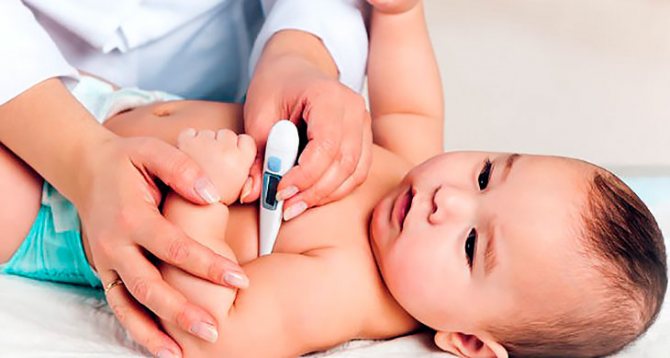
What do cramps look like when a child has a fever? This is a tonic-clonic type, which lasts a short time and is generalized. The appearance of seizures does not at all indicate any disease: they can occur in completely healthy children, and their peak manifestations occur at the age of 1 - 2 years. They occur when the temperature rises, and there are no signs of damage to the central nervous system: no headache, nausea and vomiting, or other previous symptoms.
In order for a seizure to occur, the temperature must exceed 38 degrees: with low-grade fever, seizures do not occur. Therefore, if an attack occurs, for example, at a temperature of 38.5 degrees, then in the future it is better not to bring it to such numbers, but already at a temperature of 37.5 - 37.8 to begin to actively fight against overheating of the body.
Such convulsions occur against the background of acute respiratory viral infections, vaccination reactions and other “general” causes of fever.
What are the symptoms and what does a febrile seizure look like in a child? Most often, the baby stops reacting to others, he begins to hold his breath and begins to “turn blue,” which especially frightens the parents. Then the tonic component begins: the head is thrown back, the neck tenses, then twitching movements occur in the limbs (clonic phase). Eye rolling, diffuse weakening of muscle tone, and spontaneous bowel movements and urination may occur. Most often, the duration of the attack does not exceed 10 - 15 minutes, and passes on its own. Febrile seizures do not require any anticonvulsant therapy.
Neuroinfections
If a child has meningitis with severe headache, hyperesthesia, vomiting, which is often sudden, “fountain”, and is cerebral in nature, then a convulsive attack may very likely develop.
Naturally, focal neurological symptoms will occur, and in this case, urgent hospitalization in the department of neuroinfections is required. There, a mandatory lumbar puncture will be performed, which will immediately cause relief, and antibacterial therapy will be prescribed.
- Treatment at home is unacceptable and dangerous to the health and even the life of the baby.
Convulsions in a child at normal body temperature
It is known that convulsions in a child against the background of normal temperature and complete health frighten parents even more, simply because they take them by surprise. Most often this happens when there is a violation of the concentration of various electrolytes in the blood plasma:
- When the level of calcium in the blood decreases. The child develops a characteristic posture with arms bent and brought to the stomach. The abdomen is swollen, and the hands are down, and resemble the “obstetrician’s hand.” The flexor muscles contract. A spasm of the orbicularis oris and ocular muscles occurs: a “fish mouth” appears, and before an attack, “goosebumps crawl” over the body.
- When the amount of magnesium in the blood plasma decreases. Often a convulsive generalized attack is preceded by increased excitability and muscle tremors;
- For hypoglycemia. It is often the onset of type 1 diabetes. The child develops weakness and diffuse sweating. Muscle tone decreases, tremors or trembling in the hands begin. Palpitations appear and breathing becomes impaired. With hypoglycemia, coma often occurs, against the background of which convulsions develop. After this, consciousness is not restored and the coma worsens unless glucose is urgently administered;
- With epilepsy, the recurrence of attacks and their clinical picture will be characteristic, as well as the presence of a sleep phase after an attack, which does not happen with other convulsive conditions.
Symptoms and diagnosis

The symptoms of seizures depend on the nature of muscle contraction. But in general we can talk about the following general features:
- Various tics and twitches;
- Uncontrolled movements of arms or legs;
- Distortion of facial features;
- Rolling eyes;
- Lockjaw;
- Pale skin and bluish tint to lips;
- Excessive salivation;
- Freezing in an unnatural position;
- Nausea and even vomiting.
The child may wet himself or faint. After an attack, he will most likely become capricious, but at the same time he will be sleepy and lethargic.
How to recognize epileptic seizures? During them, the baby falls to the floor and begins to convulse. His eyes roll back, foam appears on his lips, his jaw clenches. The child loses consciousness. The patient is able to wet himself or have involuntary bowel movements. Coming out of an attack is accompanied by disorientation and loss of memory of what happened. At the end of epileptic convulsions, the child experiences muscle relaxation and falls asleep.
Only a doctor can determine exactly why the seizures started. He decides which therapeutic course to choose.
But before this, the doctor collects anamnesis, analyzes how the seizure began, and prescribes tests. They usually include a blood test and electroencephalography. Sometimes computed tomography, pneumoencephalography, angiography, and spinal puncture are required.
Convulsions are dangerous because their consequences are unpredictable. During an attack, a child’s brain functions are weakened, and virtually no oxygen is supplied. Because of this, necrosis of brain cells begins, which leads to problems with the neuropsychic system and developmental delays.
General convulsive syndromes are the most serious, since the baby has absolutely no control over the body and is unconscious. During an uncontrolled seizure, epileptics run the risk of suffocating on saliva and vomit and biting off their tongue.
Why are night attacks dangerous? The baby finds himself alone with the disease, without the help of adults. This condition can even lead to death.
First aid for a baby
During a seizure, it is important to provide timely assistance to the baby - this will reduce the duration of the attack and prevent the development of favors.
The algorithm is as follows:
- At the first sign of illness, place the baby on the bed,
- Remove all hard and sharp objects from the child’s reach,
- Place your baby on his side to prevent him from choking on saliva.
- If there is a fever, rub the child's body with alcohol or cool water. Avoid contact of liquid with eyes and mucous membranes,
- If the baby begins to choke, bring a cotton swab soaked in ammonia to his nose.
Important!
The bones of a newborn are very fragile - it is forbidden to straighten the arms or legs and forcefully fix them.
First aid for seizures in children
What to do if your child has a seizure? Call an ambulance. But since the child struggles with the spasm for 2 seconds to 10 minutes, doctors may not have time to arrive. Parents need to provide some help to the baby using the following algorithm:
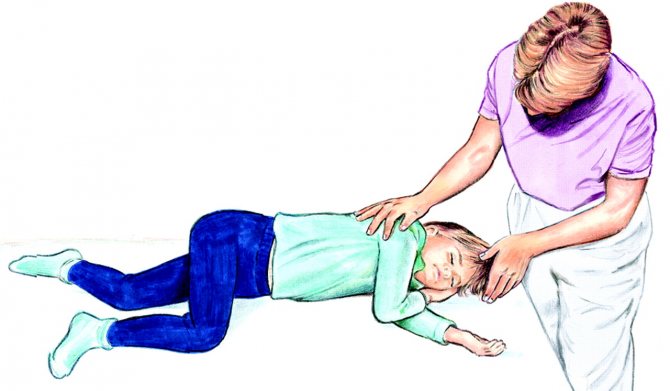
Position of the child during seizures
- Remove tight shoes and clothing, and open the window for fresh air.
- Place the baby on its side on a flat, not soft surface. Or at least turn your head to the side.
- While the convulsions last, clear your mouth of mucus by placing a roll of cloth between your teeth. This will help prevent biting or sticking of the tongue. Hard objects should not be used to avoid damaging the teeth.
- If the baby faints, try to bring him to his senses and hold out until the doctors arrive. Fainting syndrome can be relieved by applying cotton wool with ammonia, affectionate conversations, and touching.
It is especially difficult and scary for parents of infants in this situation. The baby not only does not understand what is happening to him, but also cannot say anything. It is important not to panic, to act clearly and systematically.
When a baby cries a lot, he may also experience spasms. He needs to be calmed down. An attack that has already begun is stopped by sprinkling the baby with cool water or patting her on the cheeks. Then they give a sedative, for example, valerian in the proportion: 1 drop per 1 year of life. A sedative will also help cope with attacks caused by vivid dreams. And cramps in the calf muscles, when the baby’s leg cramps, are eliminated with a light massage.
Children's antipyretics (Ibuprofen, Paracetamol) will help prevent febrile convulsions that occur against a background of high fever. You can also apply cool compresses or wraps. In a febrile state, when the heat is combined with pallor and chills, cooling procedures should not be done. Such symptoms characterize white fever - a very dangerous condition in a child.
The doctor may prescribe injections of No-shpa in the proportion of 1 mg per kilogram of weight. An older child can be given a tablet of this drug - No-shpa is well tolerated by children. And emergency assistance must be called.
Types and features
Types of seizures in children
The nature of a convulsive attack can be different, from ordinary muscle twitching to uncontrolled twitching of the limbs and rotation of the eyes. After awakening, the symptoms usually disappear, but the child’s well-being deteriorates significantly. There are five main types of seizures, which have specific causes and characteristics of how a seizure occurs during sleep in a child.
Tonic
The attack is characterized by a prolonged contraction of the muscle fibers of the limbs, with periodic “freezing” in an extended or bent position. During a seizure, the body is fully extended and the head is thrown back. Possible loss of consciousness. Convulsions occur gradually, but last a long time. The reason is overexcitation of brain structures.
Clonic
During clonic convulsions, dynamic muscle contraction is observed, while the movement of the upper and lower extremities, as well as the body itself, is uncontrolled and chaotic. More often, seizures occur when a child takes a “lying on his stomach” position during sleep. A combination of clonic and tonic symptoms of an attack is possible. The cause is hypoglycemia (lack of glucose in the blood), meningitis or intoxication.
Febrile
Febrile seizures occur in children under six years of age. A characteristic feature of a seizure is a slight contraction of muscles, loss of consciousness, uncontrolled holding of breath, and blue discoloration of the skin. Children who have a hereditary predisposition to seizures often suffer. The reason is a sharp rise in high temperature.
Respiratory-affective
The most common type of seizure. Respiratory-affective convulsions are observed in children aged from six months to three years. A seizure is expressed in the form of a sudden contraction of the respiratory muscles, which causes breathing to be held. The convulsions do not last long. Occurs more often when sleeping on the stomach. The reason for their occurrence is emotional overstimulation during the day.
Epileptic
The most serious and dangerous form of seizures. The seizure begins suddenly, the functionality of the limbs is impaired, all muscles cramp, the sensitivity of the arms and legs is lost, and the child is not able to control their movement. Together there is a shutdown of brain activity and loss of consciousness. Possible tongue swallowing. All body movements are sharp, strong and uncontrolled. The reason is neural discharges inside the cerebral cortex.
Most common reasons
A seizure attack can begin at any time if there is increased activity in his brain. After all, this is what leads to uncontrolled muscle contraction and twitching. With frequent seizures, one may suspect the development of epilepsy in a child, which is a serious disorder, but in most cases such seizures are harmless.
Night cramps in a child can be triggered by the following factors:
- meningitis, in which hypoxia occurs, which leads to convulsions;
- sleeping in flickering light, for example, if a child sleeps watching TV;
- brain injuries and pathologies;
- congenital disorders of the brain;
- lack of certain essential elements in the body (calcium, magnesium and potassium);
- poisoning;
- overwork of the body due to lack of sleep.
During an attack of convulsions that occurs during sleep, the child’s muscles tense or tremble, and the eyes roll. After an attack, the child experiences a headache and may wake up but feel more tired. Rarely does a seizure develop after sleep.
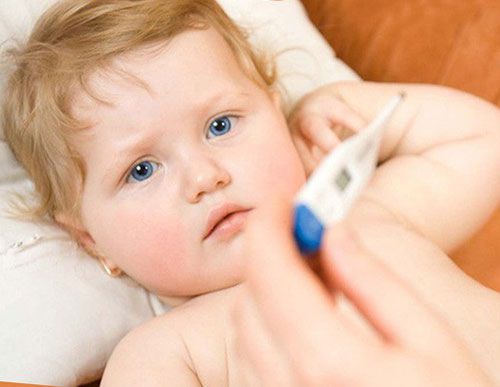
Febrile convulsions may occur during sleep, which develop due to fever
They can only appear in children aged 6 months to 5-6 years, and are a specific manifestation. Most often, the body temperature in this case rises above 38-39 degrees. About one in three children who have febrile seizures have a genetic predisposition to them.
Causes of cramps and muscle twitches - an overview
The manifestation of convulsive reactions of the body is typical for every person, especially under certain conditions. Abnormal discharges in the brain cause uncontrolled contraction of muscle fibers and involuntary twitching. Such attacks are harmless and fairly one-time.
Seizures in babies can occur due to the following reasons:
- lack of sleep;
- various brain lesions;
- hypoxia;
- malignant tumors;
- flickering of light when electronic devices are operating in the room;
- inflammation of the meninges;
- deficiency of potassium, magnesium and calcium;
- brain injuries;
- intoxication;
- congenital malformations of brain structures.
During such convulsive attacks, the baby feels pain and may roll his eyes violently. At this time, the muscles tremble and are very tense. But febrile spasms occur against the background of general fever and temperature in children from six months to five years.
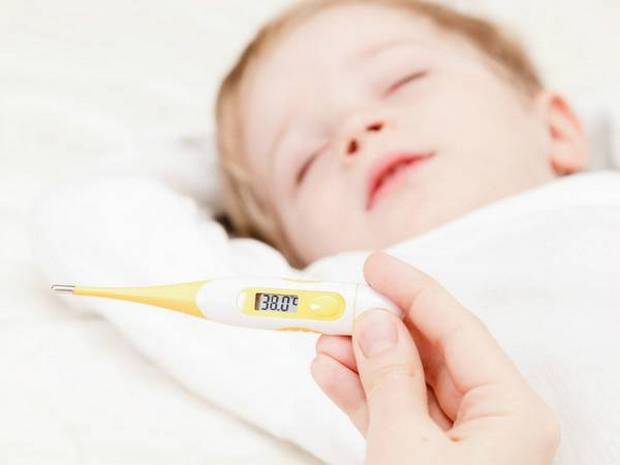
At temperatures above thirty-nine degrees, attacks may occur that last no more than two minutes. This phenomenon can be hereditary and occurs in thirty percent of children.
